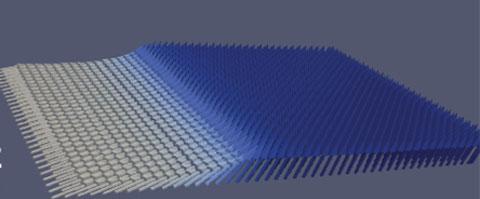Small tilt in magnets makes them viable memory chips

This image taken from a computer simulation shows nanomagnets tilted at various angles, with the white regions indicating greater angles of tilt. Researchers have found that even a small tilt of 2 degrees will facilitate magnetic switching. Image by Samuel Smith, UC Berkeley
The advance, to be reported Monday, Aug. 3, in the Proceedings of the National Academy of Sciences, could lead to computers that turn on in an instant and operate with far greater speed and significantly less power.
A research team led by Sayeef Salahuddin, an associate professor of electrical engineering and computer sciences, has found that a slight tilt of the magnets makes them easy to switch without an external magnetic field. This opens the door to a memory system that can be packed onto a microprocessor, a major step toward the goal of reducing energy dissipation in modern electronics.
“To reduce the power draw and increase the speed, we want to be able to manufacture a computer chip that includes memory so that it is close to the computational action,” said Salahuddin. “However, the physics needed to create long-term storage are not compatible with integrated circuits.”
Creating and switching polarity in magnets without an external magnetic field has been a key focus in the field of spintronics. Generating a magnetic field takes power and space, which is why magnets have not yet been integrated onto computer chips.
Instead, there are separate systems for long-term magnetic memory. These include a computer's hard disk drive where data are stored, and the various kinds of random-access memory, or RAM, on the integrated circuits of the central processing unit, or CPU, where calculations and logic operations are performed.
A large portion of the energy used in computing is spent on transferring data from one type of memory to another. Doing that quickly takes more energy and generates more heat.
In past research, Salahuddin and his colleagues found that directing electrical current through the rare metal tantalum creates polarity in magnets without an external magnetic field. But the battle wasn't over.
Packing a sufficient number of nanomagnets onto a chip meant aligning them perpendicularly, but that vertical orientation negated the switching effects of tantalum.
“We found that by tilting the magnet – just 2 degrees was enough – you get all the benefits of a high-density magnetic switch without the need for an external magnetic field,” said Salahuddin.
###
The study's lead author is Long You, a research scholar in Salahuddin's lab.
The Department of Energy, National Science Foundation Center for Energy Efficient Electronics Science, and the Semiconductor Technology Advanced Research Network's Function Accelerated nanoMaterial Engineering Center (STARNET FAME) helped support this research.
Media Contact
All latest news from the category: Information Technology
Here you can find a summary of innovations in the fields of information and data processing and up-to-date developments on IT equipment and hardware.
This area covers topics such as IT services, IT architectures, IT management and telecommunications.
Newest articles

Properties of new materials for microchips
… can now be measured well. Reseachers of Delft University of Technology demonstrated measuring performance properties of ultrathin silicon membranes. Making ever smaller and more powerful chips requires new ultrathin…

Floating solar’s potential
… to support sustainable development by addressing climate, water, and energy goals holistically. A new study published this week in Nature Energy raises the potential for floating solar photovoltaics (FPV)…

Skyrmions move at record speeds
… a step towards the computing of the future. An international research team led by scientists from the CNRS1 has discovered that the magnetic nanobubbles2 known as skyrmions can be…





















